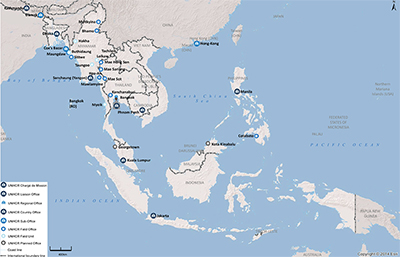Home > Where We Work > Asia and the Pacific > South-East Asia > Viet Nam
2015 UNHCR subregional operations profile - South-East Asia
| Overview |
Available protection space for refugees, asylum-seekers and stateless people in the region is fragile and unpredictable, due to a lack of national legal frameworks in most South-East Asian countries. Furthermore, some States have introduced increasingly restrictive policies - such as denying safe disembarkation or access at the airport, and narrowing protection space and access to asylum. There is also an increase in maritime "push backs" and instances of refoulement.
Only three States are parties to the 1951 Refugee Convention and only one State has signed the 1954 Statelessness Convention. The lack of asylum laws and diversity of national legal frameworks, as well as government practices and protection environments in the region's countries, make achieving regional harmonization challenging.
A major component of UNHCR's work remains to increase the protection space for all groups of concern and to advocate with States in South-East Asia to establish effective legal frameworks governing the protection of refugees and stateless populations. A significant number of refugees and asylum-seekers in the region reside in urban settings, and some States without national asylum systems consider them to be illegal migrants, thereby subjecting them to detention, expulsion, refoulement, and other serious protection risks. The lack of legal status also prevents people of concern from accessing the labour market and basic services, including health care and education.
The irregular movements of people of concern in the region pose grave dangers to those who undertake them, with an increase in maritime movements and a loss of life at sea. They also present serious challenges in balancing governments' international obligations to provide fair access to protection and asylum to those in need, with the need to combat people-smuggling and human-trafficking networks, and the legitimate interest of States to maintain control of national borders.
In Myanmar,escalating inter-communal conflict in Rakhine State in June 2012 resulted in internal displacement as well as outflows to other regional countries, including irregularly by sea. An increasing number of women and children are risking their lives in unseaworthy boats. There are reports of exploitation, violence, trafficking, forced labour, as well as abuse in transit perpetrated to extract additional payment from relatives.
UNHCR will advocate upholding the rights of people of concern and States' adherence to international protection standards, in cooperation with the governments concerned and with the support of regional institutions and civil-society actors. Such cooperation aims to promote government ownership of refugee protection, particularly regarding refugees' access to protection, basic services and registration.
Where the necessary conditions are in place, comprehensive solutions and approaches will be pursued, including local integration, voluntary repatriation, resettlement, labour options and temporary stay arrangements.
UNHCR in South-East Asia will focus on establishing protection-sensitive responses to mixed migration, registration and documentation. It will support access to asylum and refugee status determination (RSD), and promote alternatives to detention. Additionally, the Office will continue to implement strategies aimed at improving protection and durable solution prospects for urban refugees, including targeted assistance to the most vulnerable urban refugees, and preventing refoulement.
The organization will continue to work with States to promote and implement comprehensive protection-sensitive responses to irregular movements of people and mixed migration, through regional initiatives, including the Regional Cooperation Framework endorsed by the Bali Process. A Regional Maritime Movements Monitoring Unit has been established in the Regional Office for South-East Asia, based in Bangkok.
UNHCR will continue to collaborate with the Association of South-East Asian Nations (ASEAN) human rights mechanisms and other entities on statelessness and refugee protection. It will continue to promote birth registration among all populations of concern to prevent statelessness and increase child protection. In a number of key States, UNHCR is working with governments to help reduce statelessness among minority communities.
| Response and implementation |
Operations in Myanmar and Thailand are presented in separate country chapters. For other countries where UNHCR operates in the subregion, please see below.
In early 2014, the Government of Bangladesh announced its national strategy for Myanmar refugees and undocumented Myanmar nationals, acknowledging their need for basic humanitarian relief. UNHCR hopes that this will enable unregistered refugees to access international protection. Meanwhile, UNHCR provides protection and life-sustaining assistance to refugees residing in the two official camps, pending the identification of durable solutions. The organization advocates for the prevention of statelessness, more self-reliance opportunities for urban refugees and durable solutions.
In Indonesia, UNHCR continues to provide mandate protection to refugees and asylum-seekers in a number of urban locations through registration, RSD, documentation and processing for resettlement and repatriation, where possible. The detention of refugees and asylum-seekers and the widespread location of people of concern remain key protection challenges in Indonesia, particularly for a growing number of children and detainees with specific needs. To improve the protection environment, the organization will support the capacity of local authorities. It will also assist those with specific protection needs, though funding shortfalls limit the number of people likely to benefit.
In Mongolia, UNHCR will continue to conduct RSD while advocating for the Government to establish asylum procedures and to promote further measures to address statelessness including potential accession to the 1954 Convention relating to the Status of Stateless Persons, and to the 1961 Convention on the Reduction of Statelessness.
Malaysia is not party to the 1951 Refugee Convention and lacks a legislative and administrative framework to address refugee matters. As all asylum-seekers and refugees are treated as irregular migrants, and in the absence of any substantive engagement by the authorities, UNHCR remains the principal actor in providing international protection. The Office will continue to address the issue of statelessness, including by identifying and seeking to reduce the number of people with undetermined nationality at risk of statelessness. UNHCR will also advocate regularizing the legal status of people of concern including through alternative stay arrangements and labour migration schemes.
The Emergency Transit Mechanism for resettlement processing will continue in the Philippines. Efforts to strengthen the national protection regime,in collaboration with government agencies and humanitarian partners, will continue. A complementary protection framework for people falling outside the Refugee Convention definition will be pursued. In the southern Philippines, UNHCR will co-lead the protection cluster with the Government's Department of Social Welfare and Development, to coordinate a response to the internal displacement situation.
UNHCR also works with communities of Indonesian origin living in southern Mindanao, as well as relevant government authorities and civil society, to resolve the nationality status of 6,015 people of concern under UNHCR's statelessness mandate.
The organization promotes the civil registration of all people of concern, and is active in improving civil registration and vital statistics in Asia and the Pacific. The Regional Office is pursuing better refugee protection in Cambodia and Timor-Leste by supporting asylum procedures and capacity building, as well as working with the Government of Viet Nam to resolve the nationality status of the remaining populations of concern under UNHCR's statelessness mandate.
| Financial information |
Since 2011, the financial requirements in the subregion have been affected by various developments, including in Myanmar by population displacement in Rakhine State in mid-2012, the escalation of conflict in Kachin State and the possibility of refugees voluntarily returning to Myanmar from Thailand as the peace process continues. In the Philippines, UNHCR has been involved in the coordinated humanitarian response to internal displacement caused by a series of natural disasters, the most recent being Typhoon Haiyan in late 2013. The subregional budget for 2015 stands at USD 157 million.
| UNHCR 2015 budgets for South-East Asia (USD) | |||||
|---|---|---|---|---|---|
| Operation | 2014 Revised budget (as of 30 June 2014) |
2015 | |||
| Refugee programme PILLAR 1 |
Stateless programme PILLAR 2 |
IDP projects PILLAR 4 |
Total | ||
| Total | 159,110,944 | 92,606,996 | 17,724,931 | 46,644,125 | 156,976,052 |
| 1. Includes activities in Cambodia and Viet Nam (from 2015). 2. As from 2015 Viet Nam is reported under Thailand Regional Office. |
|||||
| Bangladesh | 12,385,988 | 14,425,575 | 8,731 | 0 | 14,434,305 |
| Indonesia | 8,146,793 | 6,910,233 | 89,942 | 0 | 7,000,175 |
| Malaysia | 20,161,428 | 16,410,089 | 830,521 | 0 | 17,240,610 |
| Myanmar | 68,108,703 | 10,746,411 | 13,848,084 | 43,178,231 | 67,772,726 |
| Philippines | 9,677,822 | 1,059,787 | 952,090 | 3,465,894 | 5,477,770 |
| Thailand | 32,803,303 | 36,035,542 | 1,197,917 | 0 | 37,233,459 |
| Thailand Regional Office[1] | 7,389,703 | 7,019,359 | 797,647 | 0 | 7,817,006 |
| Viet Nam[2] | 437,203 | - | - | - | - |
Source: UNHCR Global Appeal 2015 Update














